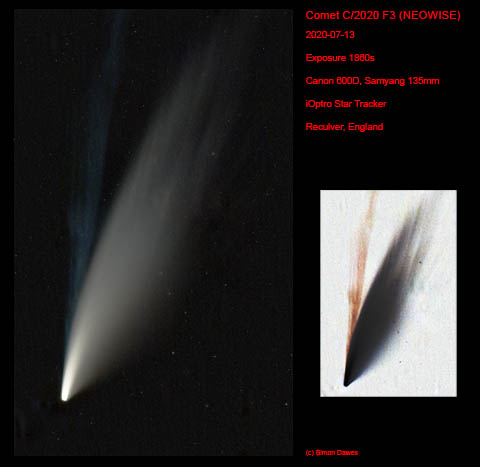Forum Replies Created
-
AuthorPosts
-
 Simon DawesParticipant
Simon DawesParticipantThanks for telling me what you use Paul. Do you have any comment on my workflow, and if there is anything fundamentally wrong with the approach (you know those gotchas that aren’t obvious to someone new to astrometry)
 Simon DawesParticipant
Simon DawesParticipantHere are my images from Bexleyheath in Greater London (Bortle 8)
limiting mag is usually about 3.5 – 4 on a clear night. Simon DawesParticipant
Simon DawesParticipant Simon DawesParticipant
Simon DawesParticipant 2020-07-12 2240UTforum.jpg)
Another – I’ll stop boring everyone now 🙂
 Simon DawesParticipant
Simon DawesParticipantQuick 10s image of teh comet at Reculver Towers last night.
Full image here https://britastro.org/node/23239
Simon
 Simon DawesParticipant
Simon DawesParticipantThanks I’ll give them a go, ffmeg I’ve used for video, I didn’t realise it handled FITS as well.
 Simon DawesParticipant
Simon DawesParticipantAh – I have PIPP didn’t realise it did this 🙂 thanks!
 Simon DawesParticipant
Simon DawesParticipantHere are a couple of time lapse images of the comet.
https://www.youtube.com/watch?v=NpVRDDABx7s&feature=youtu.be
https://www.youtube.com/watch?v=GdoG84oF4vs&feature=youtu.be
Does anyone know how to calibrate RAW files and save as RAW or tif? All my software saves them as FITS which are no good for creating time-lapse videos. Or how to batch convert fits to tiff or jpg?
 Simon DawesParticipant
Simon DawesParticipantHere is one of my stacks from Friday/Saturday night – I went out with a few friends and we observed from dusk ’till dawn.

full image on my members page https://britastro.org/profile?id=7740
 Simon DawesParticipant
Simon DawesParticipantSo my point was that the blue dots represent the peak pixel value, these you can see start to saturate and longer exposures don’t increase the peak value linearly – the orange dots are the sum of all the values in the central apature, when you sum these up, the result appears to continue to be linear.
My point really is that whilst the advice is ‘stay within the linear range of the sensor‘ – which I do do – for my sensor at least – the actual practical process of counting the electrons is done not on single pixels but on a defined area of pixels and when this is taken into account the linear range seems to extend well beyond that of the linear range of individual pixels, and if this is the case it might have some practical application.
BTW I’m not really disagreeing just pointing out that it seems interesting… 🙂
 Simon DawesParticipant
Simon DawesParticipantI just looked at my master darks from the ZWO ASI 1600MM Pro all cooled to -10C. I took measurements from each corner and the centre of the sensor for each master dark in my library and the amp glow looks linear with exposure time to me…
This is a very new field for me so there might be something wrong with my approach or analysis.
 Simon DawesParticipant
Simon DawesParticipantRE? Looking at your graphs, they show a slightly different behaviour in the linear region. It appears to be a steeper slop, followed by a little bit of a wiggle.
I think this is just environmental conditions rather than something inherent in the sensor – I may be wrong – it was a quick test with pre-existing data, little thought was taken into what star to choose – I don’t think they were even calibrated.…
 Simon DawesParticipant
Simon DawesParticipantI use a ZWO ASI 1600 pro Mono CMOS camera for photometry this is a 12 bit sensor.
I’ve observed 7 exo-planets – as part of EXO-Clock without any problems – I tend to use darks that are the length of the exposure but the HOPS software will scale them anyway to create darks for the flats.
The sensor I’m using is very linear – as far as I can tell – this is looking at the peak pixel in a 100 pixel radius near the centre of the field.
I get similar results on star tests.
I’ve also noticed if you look at integrated counts – as photometry software does – and use the right apature then the integrated counts remain linear even when some of the pixels are saturated – however I’m told to stay within the linearity of the chip – so I do – I’m a beginner when it comes to photometry so perhaps someone can tell me why this is so…
 Simon DawesParticipant
Simon DawesParticipantI didn’t know Gordan personally but he was the founder of the Crayford Manor House Astronomical Society, which I’ve been a member for at least 25 years. There is a video of Gordon being presented a special award by Roger Pickard for his outstanding contribution to astronomy.
-
AuthorPosts







